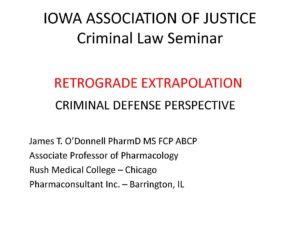Retrograde Extrapolation
One of the key roles of the pharmacologist as an expert witness is to predict the concentration of drugs and alcohol at the time of an arrest or accident based on a concentration measured later. The concentration may have important consequences
in itself as in the case of the legal limit of intoxication; it also is important to help determine the level of impairment, if any, at the time of an incident. In the case of alcohol, the kinetics of elimination make extrapolating a measured concentration backwards to predict an earlier concentration relatively simple. This is called Retrograde Extrapolation. Let’s consider a typical alcohol concentration vs. time curve. First, the concentration rises as the alcohol is being absorbed—this is called the absorption phase. Once the concentration reaches its peak, the alcohol is in the elimination phase and will decrease in a linear fashion. Because of this linearity, you can predict the concentration at an earlier time based on the measured concentration and the known rate of elimination. The rate of elimination can either be taken from a population average, or it can be calculated if the alcohol concentration has been measured at two different times. The one caveat is that the alcohol must be fully absorbed by the time of the incident in question; in other words, the alcohol must be in the elimination phase for the entire time between the time of the incident and the time of the BAC measurement. If this is NOT the case, you may still be able to still provide an estimate of a range of possible concentrations, but you cannot pinpoint an exact concentration. So that is retrograde extrapolation in a nutshell.